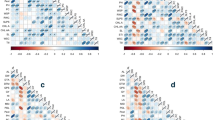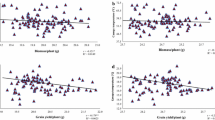Abstract
Wheat grain yield is limited due to terminal heat stress. Inconsistency of the previous results reflects the interactions between genotypes and environments. In North West Plain Zone (NWPZ), where the hot, dry wind is frequent during grain filling, wheat cultivars suffer from loss of grain weight because of low grain filling rate. A field study was carried out under late sown conditions in NWPZ to evaluate the phenological variations using heat-accumulated system and its relation with yield in twenty five wheat genotypes. Grain yield was positively correlated with days to heading, biological yield, harvest index and grain number per spike in both timely (TS) and late sown (LS) varieties, while grain weight and flag leaf area also showed positive correlation with grain yield in LS varieties. Grain growth rate (GGR) at 14 and 28 days after anthesis (DAA) showed positive correlations with grain weight in TS, and in LS genotypes flag leaf area was positively correlated with GGR at 14 DAA. Increasing days to heading resulted in higher grain yield, while increasing grain filling duration has little effect. PBW 343 and WH 711 in TS varieties and WH 1022 and PBW 373 in LS group had highest grain yields in their respective groups among the genotypes studied. These genotypes tended to have relatively longer pre-heading periods with medium maturity. The results of this study indicate that NWPZ adapted cultivars would have long pre-heading periods, moderate grain filling duration, high grain filling rates and mature early to avoid late-season drought and high-temperature stresses to attain high yields. Therefore, high yielding wheat cultivars adapted to subtropical environments can be develop by selecting the genotypes with medium maturity and a relatively long time to heading.




Similar content being viewed by others
References
Al-Khatib, K., & Paulsen, G. M. (1984). Mode of high temperature injury to wheat during grain development. Plantarum Physiologia, 61, 363–368.
Alvaro, F., Isidro, J., Villegas, D., Garcia Del Moral, L. F., & Royo, C. (2008). Breeding effects on grain filling, biomass partitioning, and demobilization in Mediterranean durum wheat. Agronomy Journal, 100, 361–370.
Amin, M. R., Bodruzzaman, M., Shaheed, A., & Razzaque, M. A. (1995). Effect of size of wheat seed on yield. Bangladesh Journal of Animal Science, 22, 347–349.
Anikiew, V. V., & Kutuzov, F. F. (1961). A new method for determining leaf surface area of cereals. Soviet Plant Physiology, 8, 193–197.
Bidinger, F., Musgrave, R. B., & Fischer, R. A. (1977). Contribution of stored pre-anthesis assimilate to grain yield in wheat and barley. Nature, 270, 431–433.
Burton, G.W. (1952). Quantitative inheritance in grasses. Proceedings 6th International Grassland Congress 1:277–283
Cruz-Aguado, J. A., Reyes, F., Rodes, R., Perez, I. P., & Dorado, M. (1999). Effect of source to-sink ratio on partitioning of dry matter and 14C-photoassimilates in wheat during grain filling. Annals of Botany, 83, 655–665.
Evans, L. T., Wardlaw, F. T., & Fischer, R. A. (1975). Wheat. In L. T. Evans (Ed.), Crop Physiology: Some Case Histories. Cambridge: Cambrideg University Press.
Garcia del Moral, L. F., Rharrabti, Y., Villegas, D., & Royo, C. (2003). Evaluation of grain yield and its components in durum wheat under Mediterranean conditions: an ontogenic approach”. Agronomy Journal, 95, 266–274.
Grafius, J. E. (1978). Multiple characters and correlated response. Crop Science, 18, 931–934.
IPCC (2013). The physical science basis. Summary for policymakers, 5th assessment report of the intergovernmental panel on climate change.
Jedel, P. E., & Hunt, L. A. (1990). Shading and thinning effects on multi-and standard-floret winter wheat. Crop Science, 30, 128–133.
Johanson, H. W., Robinson, H. F., & Comstock, R. E. (1955). Genetic and environmental variability in soybean and their implication in selection. Agronomy Journal, 47, 314–318.
Ma, Y. Z., MacKown, C. T., & Van Sanford, D. A. (1990). Sink manipulation in wheat: Compensatory changes in kernel size. Crop Science, 30, 1099–1105.
Metzger, D. D., Czaplewski, S. J., & Rasmusson, D. C. (1984). Grain filling duration and yield in spring barley. Crop Science, 24, 1101–1105.
Panse, V. G., & Sukhatme, P. V. (1961). Statistical Methods for Agricultural Workers. New Delhi: ICAR.
Sanchez, A. C., Subudhi, P. K., Rosenow, D. T., & Nguyen, H. T. (2002). Mapping QTLs associated with drought resistance in sorghum (Sorghum bicolor L. Moench). Plant Molecular Biology, 48, 713–726.
Savin, R., & Slafer, G. A. (1991). Shading effects on the yield of an Argentinian wheat cultivar. Journal of Agricultural Science, 116, 1–7.
Savin, R., Stone, P. J., Nicolas, M. E., & Wardlaw, I. F. (1997). Grain growth and malting quality of barley. 2. Effects of temperature regime before heat stress. Australian Journal of Agricultural Research, 48, 625–634.
Shezad, K., Bakht, J., Ali Shah, W., Shafi, M., & Jabeen, N. (2002). Yield and yield components of various wheat cultivars as affected by different sowing dates. Asian Journal of Plant Science, 1, 522–525.
Slafer, G. A., & Savin, R. (1994). Source-sink relationships and grain mass at different positions within the spike in wheat. Field Crops Research, 37, 39–49.
Strunk, W, Jr, & White, E. B. (1979). The Elements of Style (3rd ed.). New York: Macmillan.
Tewolde, H., Fernandez, C. J., & Erickson, C. A. (2006). Wheat cultivars adapted to post-heading high temperature stress. Journal of Agronomy and Crop Science, 192, 111–120.
Thorne, G. N. (1974). Physiology of grain yield of wheat and barley. Representative Rothamsted Experimental Station, 2, 5–25.
Van der Geer, J., Hanraads, J. A. J., & Lupton, R. A. (2000). The art of writing a scientific article. Journal on Scientific Communication, 163, 51–59.
Wahid, A., Gelani, S., Ashraf, M., & Foolad, M. R. (2007). Heat tolerance in plants: an overview”. Environmental and Experimental Botany, 61, 199–223.
Whan, B. R., Carlton, G. P., & Anderson, W. K. (1996). Potential for increasing rate of grain growth in spring wheat. I. Identification of genetic improvements”. Australian Journal of Agricultural Research, 47, 17–31.
Winzeler, M., Monteil, P. H., & Nosberger, J. (1989). Grain growth of tall and short spring wheat genotypes at different assimilate supplies. Crop Sciences, 29, 1487–1491.
Author information
Authors and Affiliations
Corresponding author
Rights and permissions
About this article
Cite this article
Laxman, Singh, V., Solanki, Y.P.S. et al. Phenological development, grain growth rate and yield relationships in wheat cultivars under late sown condition. Ind J Plant Physiol. 19, 222–229 (2014). https://doi.org/10.1007/s40502-014-0105-8
Received:
Accepted:
Published:
Issue Date:
DOI: https://doi.org/10.1007/s40502-014-0105-8




